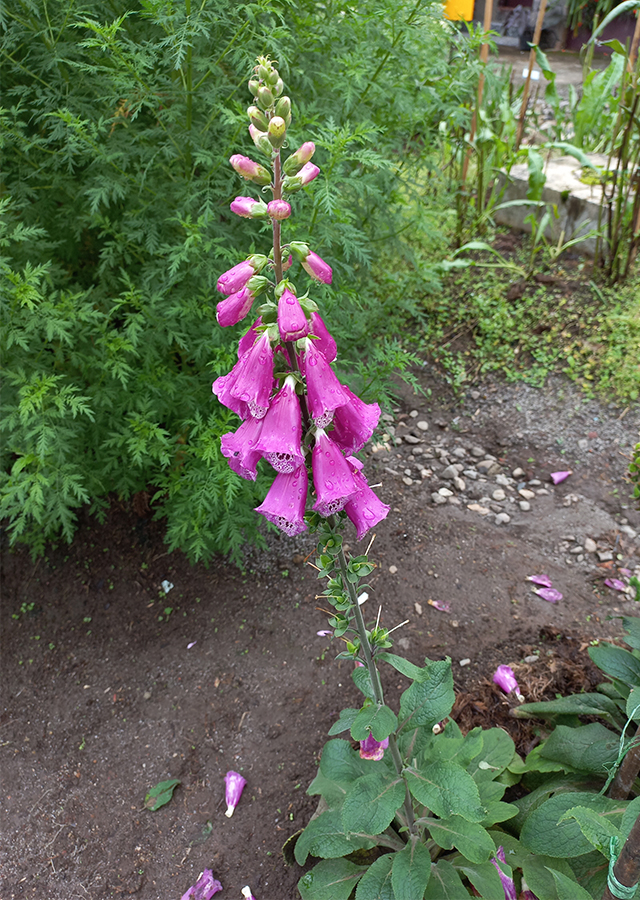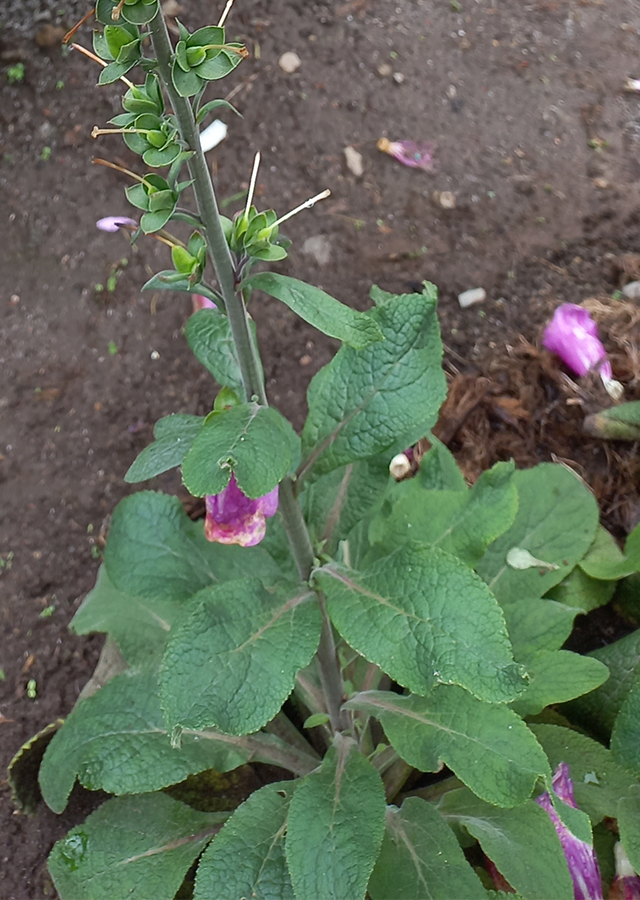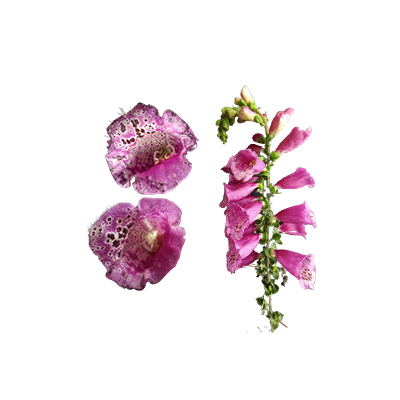Foxglove
Digitalis purpurea L.
Plantaginaceae
Location in our garden
Principal



Synonym
Digitalis alba Schrank
Digitalis carnea Meigen & Weing.
Digitalis fucata Ehrh.
Habitus
Herbaceous. A biennial or perennial herb that grows up to about 2 m tall.
Part Used
Leaves
Seeds
Growing Requirements
Full Sunshine
Need Shade
Low Temperature
Habitat
Grassland
Terrestrial
Overview
Digitalis purpurea is native to the British Isles, western Europe, and parts of Africa, but is found today as an ornamental plant throughout the world. It was named by the Swedish botanist Carl Linnaeus in his pivotal publication Species Plantarum in 1753. The generic name Digitalis comes from the Latin for finger (digitus), referring to the shape of the flowers. The specific epithet purpurea refers to the colour of the flowers, which are frequently purple (although a white-flowered form is fairly common). It was one of the many herbal remedies used by the ancient Romans. Although its use for the treatment of heart failure has been traced back to 10th century Europe, D. purpurea was not widely used for this indication until its scientific investigation by British physician William Withering in the late 1700s. For most of the 1800s, it was used to treat a wide variety of diseases and disorders.
Vernacular Names
Fingerborgsblomma (Swedish), Asabi athara hamra (Arabic), Hritpatri (India), Digitalriseu (Korean), Mao di huang (Chinese).
Agroecology
Foxglove can grow in a wide range of temperatures, temperatures ranging as low as -25 ˚C. Due do this toleration of cold temperatures, it can easily colonize wild habitats like the temperate woodlands, open woods, hedge banks, sea cliffs, dry hilly pastures, and rocky mountain slopes, though they are commonly grown in gardens as well. Requires semi-shade (light woodland) or no shade. It prefers dry or moist soil. Suitable for light (sandy), medium (loamy) and heavy (clay) soils. Suitable pH is mildly acid, neutral and basic (mildly alkaline) soils.
Morphology
- Root - branched tap root.
- Stem - erect, unbranched, grey, tomentose stem.
- Leaves - alternate, ovate, tapering upward and petiolate. Almost all are crenate; only the highest ones are entire-margined.
- Flowers - carmine red with white edged spots on the inside. The flowers appear in long hanging racemes. They have 5 free, short-tipped sepals. The corolla is about 4 cm long, campanulate, bilabiate with an obtuse upper lip and an ovate tip on the lower lip. The flower is glabrous on the outside and has a white awn on the inside. There are 2 long and 2 short stamens, and 1 superior ovary.
- Fruit - a 2-valved, ovate, glandular, villous capsule.
Cultivation
Generative propagation is by seed - surface sow early spring in a cold frame. The seed usually germinates in 2-4 weeks at 20 °C. When they are large enough to handle, prick the seedlings out into individual pots and plant them out in the summer.
Chemical Constituents
Cardiac glycosides (digitoxin, gitoxin), volatile oil, digitalis glycosides, steroidal saponins, flavones, flavonoid chrysoeriol, anthraquinones, and organic acids.
Traditional Medicinal Uses
- It is used to treat ulcers, boils, abscesses, headaches and paralysis.
- Externally, used for the granulation of poorly healing wounds and to cure ulcers.
- In South America, preparations of the powdered leaves are used to relieve asthma, as sedatives, and as diuretic/cardiotonics.
- In India, an ointment containing digitalis glycosides is used to treat wounds and burns.
Part Used
Reference Sources
- Al-Snafi, A.E. (2017). PHYTOCHEMICAL CONSTITUENTS AND MEDICINAL PROPERTIES OF DIGITALIS LANATA AND DIGITALIS PURPUREA - A REVIEW. Indo American Journal Of Pharmaceutical Sciences, Vol. 4 (02), (pg.225-234)
- Drug.com. (2021). Digitalis. https://www.drugs.com/npp/digitalis.html. 24-12-2021.
- Kew Royal Botanic Gardens. (No date). Digitalis purpurea L. https://powo.science.kew.org/taxon/urn:lsid:ipni.org:names:802077-1. 24-12-2021.
- Plants For A Future. (2021). Digitalis purpurea - L. https://pfaf.org/USER/Plant.aspx?LatinName=Digitalis+purpurea. 24-12-2021.


